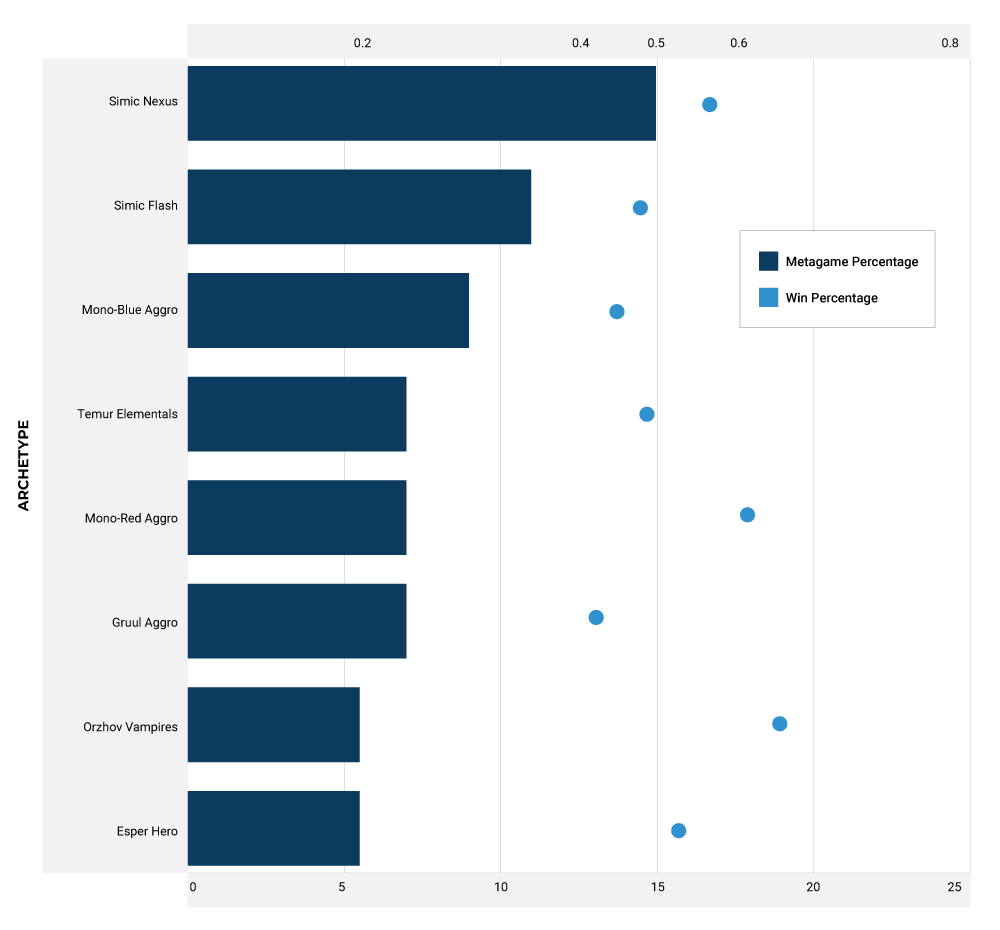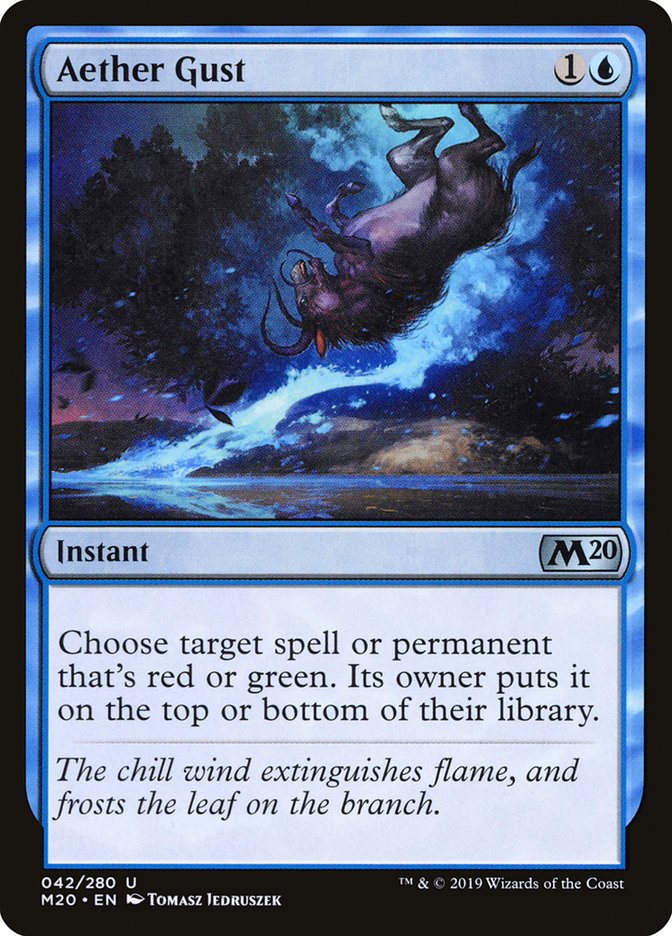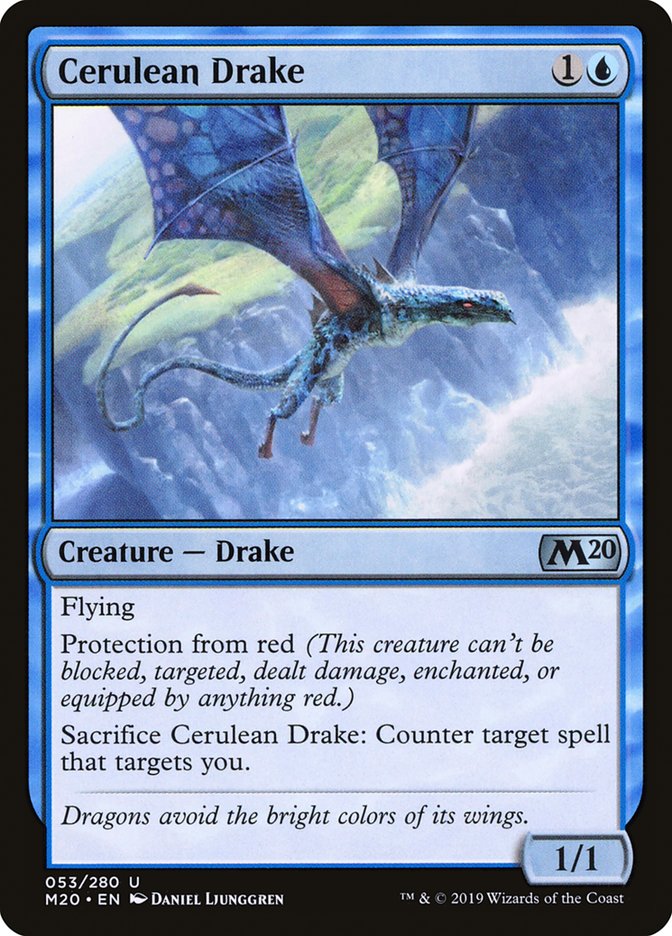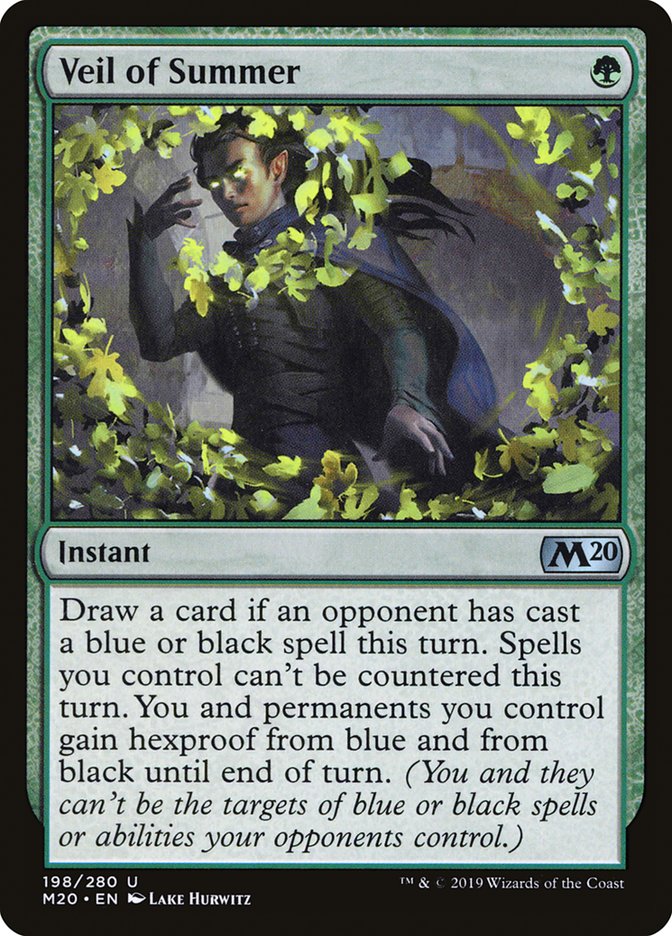Welcome back to another Mox Insights breakdown. This week, we’re deconstructing the Core Set 2020 Standard metagame of Day 2 at SCG Worcester. To be honest, this is one of the more interesting tournaments for us to look at because if you were looking only at Top 8, you’re missing most of the story.
The Matchup Spread
You came here for data and beautiful graphs and we’re here to provide them. Here’s the matchup breakdown of the Top 12 most popular decks at SCG Worcester, based on metagame share:
| Simic Nexus | 3-7 | 6-4 | 4-0 | 4-2 | 3-3 | 0-4 | 3-2 | 2-0 | 0-2 | 3-2 | 4-1 | |
|---|---|---|---|---|---|---|---|---|---|---|---|---|
| Simic Flash | 7-3 | 2-6 | 0-1 | 3-0 | 2-2 | 1-3 | 4-1 | 1-0 | 1-2 | 1-2 | 0-1 | |
| Mono-Blue Aggro | 4-6 | 6-2 | 0-3 | 1-3 | 0-1 | 3-0 | 1-0 | 1-3 | 1-3 | 0-2 | – | |
| Gruul Aggro | 0-4 | 1-0 | 3-0 | 4-3 | 1-2 | 0-3 | 0-1 | – | 1-0 | 1-2 | 0-3 | |
| Temur Elementals | 2-4 | 0-3 | 3-1 | 3-4 | 3-0 | 1-2 | 1-1 | 2-1 | 1-1 | – | – | |
| Mono-Red Aggro | 3-3 | 2-2 | 1-0 | 2-1 | 0-3 | 2-0 | 0-1 | 2-0 | 0-1 | – | 2-0 | |
| Orzhov Vampires | 4-0 | 3-1 | 0-3 | 3-0 | 2-1 | 0-2 | – | 1-0 | 1-1 | 0-2 | 3-0 | |
| Azorius Aggro | 2-3 | 1-4 | 0-1 | 1-0 | 1-1 | 1-0 | – | 1-2 | 1-1 | 1-0 | 0-1 | |
| Esper Hero | 0-2 | 0-1 | 3-1 | – | 1-2 | 0-2 | 0-1 | 2-1 | 2-1 | 3-0 | – | |
| Boros Feather | 2-0 | 2-1 | 3-1 | 0-1 | 1-1 | 1-0 | 1-1 | 1-1 | 1-2 | 1-0 | – | |
| Rakdos Aggro | 2-3 | 2-1 | 2-0 | 2-1 | – | – | 2-0 | 0-1 | 0-3 | 0-1 | 0-1 | |
| Simic Ramp | 1-4 | 1-0 | – | 3-0 | – | 0-2 | 0-3 | 1-0 | – | – | 1-0 | |
|
Simic Nexus
|
Simic Flash
|
Mono-Blue Aggro
|
Gruul Aggro
|
Temur Elementals
|
Mono-Red Aggro
|
Orzhov Vampires
|
Azorius Aggro
|
Esper Hero
|
Boros Feather
|
Rakdos Aggro
|
Simic Ramp
|
| 80 | |
| 70 | |
| 60 | |
| 50 | |
| 40 | |
| 30 | |
| 20 |
From this, a few interesting tidbits emerged that we wanted to highlight:
- Orzhov Vampires crushed Simic Nexus. Vampires seems to have just the right amount of disruption and closing speed to brawl with Simic Nexus.
- Simic Nexus actually posted a fairly even spread against the format at large, with two unfortunate matchups: Simic Flash and the aforementioned Orzhov Vampires.
- Mono-Blue Aggro had only two good matchups: Simic Flash and Orzhov Vampires.
- Boros Feather posted an excellent win rate against the Top 3 decks in Day 2.
- Mono-Red Aggro had a fairly reasonable spread across the top decks, with some solid matchups in its favor.
- Temur Elementals was the strongest deck to fight off monocolored aggressive strategies.
We also wanted to plot the metagame share that these decks held with their win percentage, so you could see the gulf between a deck’s win rate and its metagame share, as a way to see what decks are winning far more than their metagame share and what decks are perhaps not winning as much as they should.
Looking at both, some other conclusions emerged. First off, Boros Feather was a called shot from SCG writer Bryan Gottlieb, who remarked that the deck had been surprisingly powerful for him on the Arena ladder in last week’s episode of the Arena Decklists cast. This was borne out on Day 2, as Boros Feather had an astonishing 68% win-rate. It might have been carried by one of the best players on the Tour in Oliver Tomajko, but this high a win-rate is something to pay attention to. Orzhov Vampires was another stand-out in the high win-rate camp with similarly low representation.
Spells (22)
- 1 Unsummon
- 4 Opt
- 1 Negate
- 3 Spell Pierce
- 2 Lookout's Dispersal
- 4 Dive Down
- 4 Curious Obsession
- 3 Wizard's Retort
Sideboard

In contrast, Mono-Blue Aggro, despite making it to the finals of the tournament in the hands of Ross Merriam, actually posted a very poor win rate on the day, considering how popular it was. Mono-Blue and Simic Flash were relatively popular options, each around 10% of the Day 2 metagame, but they posted win rates around 45%. Interestingly, Mono-Blue Aggro performed very well against Simic Flash, suggesting to us that if players want to play a tempo-oriented strategy, adding a color has a significant cost in the mirror that should be accounted for.
Creatures (23)
- 2 Living Twister
- 4 Creeping Trailblazer
- 4 Risen Reef
- 2 Overgrowth Elemental
- 4 Omnath, Locus of the Roil
- 4 Leafkin Druid
- 3 Cavalier of Thorns
Planeswalkers (6)
Lands (24)
Spells (7)
Sideboard

Temur Elementals had its coming-out party at SCG Worcester and it did… not great. Not bad, but not great. While it certainly has some tools that are doing good things in the format – Omnath, Locus of the Roil particularly impressed on camera – the deck might need further refinement before it is widely successful. Its success seems to orient around Simic Nexus and decks that target Simic Nexus, like Simic Flash.
And what of the previous rulers of War of the Spark Standard, Mono-Red Aggro and Esper Hero? Esper Hero had a middling performance with a middling win rate. Mono-Red Aggro, on the other hand, was a consistently solid deck that struggled primarily against Temur Elementals, presumably a deck that could just close the door more quickly than Mono-Red could against its opponent.
When we did our usual scatter plot to identify the best-performing decks, we wanted to highlight a surprisingly good performance from Simic Nexus.
Planeswalkers (6)
Lands (25)
Spells (29)

Though Simic Nexus didn’t Top 8 the event, it performed very well – almost a 55% win-rate – while being also the most-represented deck archetype. The color-specific hate cards that Simic Nexus players have been talking about seem to have provided strong support for the deck as a contender in the metagame, particularly as Esper Hero finds itself under duress from new contenders like Orzhov Vampires and Temur Elementals.
Creatures (10)
Planeswalkers (6)
Lands (26)
Spells (18)
- 3 Disfigure
- 1 Cast Down
- 4 Thought Erasure
- 1 Kaya's Wrath
- 2 Enter the God-Eternals
- 3 Oath of Kaya
- 2 Tyrant's Scorn
- 1 Command the Dreadhorde
- 1 Despark
Sideboard

Counterintuitively, though, even after a middling weekend, Esper Hero might be a good choice to fight Feather if Feather is picked up more in the coming weeks. Esper Hero’s strength against Mono-Blue is also a point in its favor if results-oriented thinking predominates deck selection moving forward.
The Shape of Standard’s Sideboards
The addition of color-specific hate cards from Core Set 2020 was something we wanted to look at, specifically how many of those cards were penetrating sideboards at SCG Worcester and were they swinging matchups that those specific hate cards were exceptionally good against, say, for example, Shifting Ceratops versus Mono-Blue Aggro.
These are very small sample sizes, but they provoke interesting speculation. Some of the interesting pieces we found:
- Simic Nexus decks with at least three copies of Shifting Ceratops did 33% better against Mono-Blue Aggro than Simic Nexus decks with only one or two copies of Shifting Ceratops.
- Simic Nexus decks that played four or more copies of anti-red cards (Aether Gust and Cerulean Drake) went 3-0 versus Mono-Red Aggro, while Simic Nexus decks with fewer than four copies went 0-3. Contrasting with this, however, Simic Ramp and Simic Scapeshift each lost their two matches against Mono-Red Aggro.
- Veil of Summer seems to improve any deck’s matchup vs Mono-Blue Aggro by at least 5% and likely at least 10%.
This could, of course, just be variance. But it also could be indicative of a future consideration for Core Set 2020 Standard color-specific sideboard strategies: Simic Nexus’s ability to definitively “end” a game once they reach infinite turns allows them to use Aether Gust and Cerulean Drake as bridges to that end-game. If your deck doesn’t have this definitive end-game, like Simic Ramp or Simic Scapeshift, you could find yourself overpowered by Experimental Frenzy.
Similarly, with Veil of Summer, it seemed to be leveraged best out of decks that weren’t pressuring the Mono-Blue player. Temur Elemental and Gruul Aggro players didn’t seem to need Veil of Summer to be successful versus Mono-Blue Aggro, most likely because these decks were presenting a variety of threats with high card quality, whereas a deck like Simic Nexus needed to force through a specific threat to win and take over the game.
Again, these aren’t firm conclusions, but something to consider as you’re preparing your Standard sideboards and identifying weaknesses in your matchup spread.
Closing
This weekend, we’ll be off as players battle it out in the Team Constructed format at SCG Columbus. Perhaps this article inspires some last-second audibles as players realize that Simic Nexus is perhaps not entirely dead and that Boros Feather is a really good deck. There’s also a divergent metagame emerging: Jund Dinosaurs stampeded into the MOCS event, a deck that was virtually unknown on the Arena Mythic ladder and that was nowhere to be found in the Day 2 results from SCG Worcester. We’re confident that this metagame was only scratching the surface of what will emerge in this Standard format.
We’ll be back at the end of July to break down SCG Columbus and Mythic Championship IV and look at what post-Bridge-from-Below-ban Modern format looks like. While Wrenn and Six might have invigorated Jund enthusiasts (has anyone considered adding Chandra, Acolyte of Flame to Jund yet?), we’re going to be looking out for other ways to attack the metagame: Grixis Urza, Four-Color Scapeshift, and… perhaps Dimir Faeries (with Ninjas!).
We’ll see you then with more Mox Insights.






